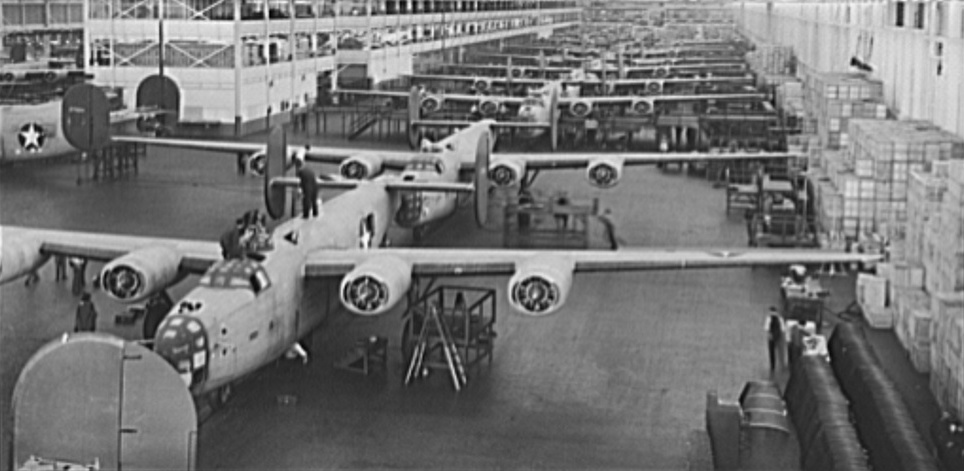Review: "Freedom's Forge" by Arthur Herman (Kindle edition)
 B24-E Liberator bombers under production at Ford’s Willow Run plant, Michigan Photo credit: Howard R. Hollem via LOC
B24-E Liberator bombers under production at Ford’s Willow Run plant, Michigan Photo credit: Howard R. Hollem via LOC
This was a book I added to my Kindle some time in 2020 when everyone was wondering how quickly the United States could ramp-up production of tests, masks, ventilators and so on. It sat unread until this year, so all I recalled upon starting it was that it recounts the reorientation of the US economy to a war footing during the Second World War.
It tells that story primarily through the experiences of two men: Bill Knudsen, until then the president of General Motors, and Henry Kaiser, a construction magnate. Knudsen I had not heard of, while I was familiar with the Kaiser name only from its contemporary presence in healthcare. In this period he is famous primarily as a builder of Liberty Ships, the merchant vessels constructed in their thousands to carry arms and other goods to the Allies in Europe.
In 1940 America was thoroughly unprepared to prosecute war across two oceans. Even once the pivot was made, the ramp-up to wartime production was far from immediate (p. 146):
That was the magic number: eighteen months. That’s how long Knudsen estimated it would take for American business and industry to make the arsenal of democracy a reality. One year to build new plants and retool the old ones, six months for conversion… Why so long to get started? Because American assembly lines could not get moving until they had the machine tools for the job.
Despite this, individual projects often did move at breakneck speed.1 Shipyards sprang up in weeks and ships rolled out of them, at their fastest, in only days. People worked not only longer and harder but smarter. Of the B-24 Liberator bomber: “Ford had turned a plane that used to cost two hundred thousand man-hours to make into one that cost only eighteen thousand hours.” (p. 241)
Some people would probably find the book too much of a march through production statistics, though I did not. Still, paragraphs like this abound (p. 200)
In 1941 the United States had made 3,964 tanks—more than twice the number of the past three years. In 1942 it produced 24,754. In 1941 it produced 617,000 small arms and 97,000 machine guns. In 1942 the numbers swelled to 2.3 million and 663,000, respectively. Whereas the previous year saw 318 B-17 and B-24 heavy bombers coming off the assembly line, 1942 saw 2,618—along with 136,000 aircraft engines, 92,000 20mm antiaircraft guns (versus 2,042 in 1941), 20,000 75mm guns, and 10 million rounds of small-arms ammunition.
One warning: the author, Arthur Herman, is unapologetically pro-business and anti-organized labor. His slant is too strong, and actually counterproductive, since I quickly began to distrust his presentation of those competing interests and their relative contributions to the war effort.
As the book progresses it becomes clear that Herman is arguing with something, though he’s not really explicit about that until the conclusion (p. 334):
Those who had been disappointed about being left out of the major decisions about the economy during the war—New Dealers and others—took their revenge by seizing control of the historical message. Business had had nothing to do with the miracle of war production, went the narrative. In fact, there was no miracle at all; it was the vast resources and extended reach of the federal government all along…
Far from demonstrating that government intervention failed to revive the American economy during the New Deal years, they argued that war mobilization proved the opposite…
The implications were profound. Keynesians asserted, in wartime or peacetime, all you had to do to generate economic growth was increase demand through growing the federal budget or by running government deficits, or both.
Reaching this I fully assumed this book was written sometime in the Thatcher/Reagan years when such a simplified narrative was last dominant on the left (albeit perhaps ascendent again just lately). But oddly no: it was published in 2012. Whatever conventional wisdom I received on the war during my economics studies, it was already by the early 2000s more aligned with Herman’s perspective than the anachronistic Keynsian strawman he argues against.
Still, look past that and this is a fascinating and worthwhile book.
-
One sobering realization I had in reading is that war materiel can be produced quickly when an economy orients around it. In a drawn-out conventional war, it probably matters very little that the United States currently has 11 aircraft carriers in service and China only 2. In extremis, a year or eighteen months could change that balance dramatically. Of course, a drawn-out conventional war between nuclear powers may well be inconceivable or meaningless today.
Still, it’s hard not to read about the web of American industry sweeping past Germany and Japan, without hearing echoes of China and the United States today, and impossible to hear the description of a ship built in 4 days without remembering China’s “hospitals in a week.” ↩
Add comment
Comments are moderated and will not appear immediately.
Comments (1)
test message